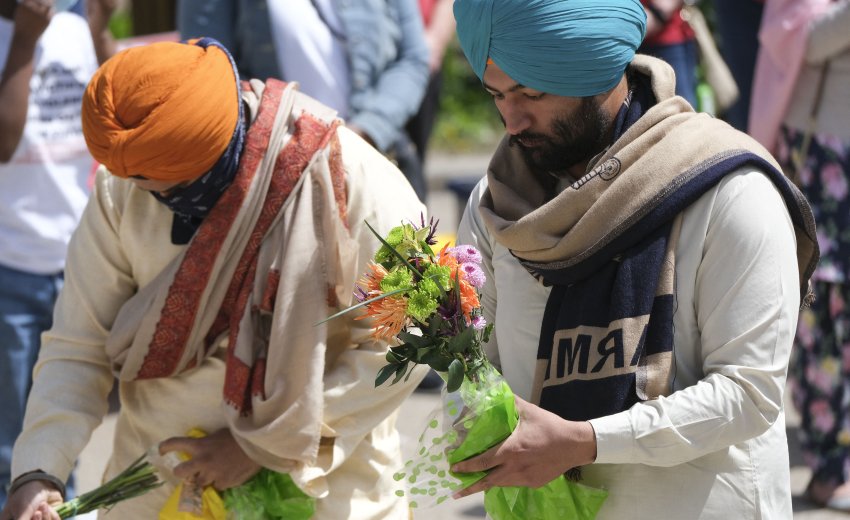The gruesome mass shooting at Indianapolis’s FedEx facility in 2021 got to the headlines and raised concern among different communities across the world. The reports suggested that the shooter intentionally targeted Sikh workers. The shooter who carried out the deadly rampage at a facility where he used to work was aware that many of the employees were Sikh Americans.
This tragedy has caused immense trauma to the Sikh American community, and Komal Chohan, the granddaughter of one of the victims, Amarjeet Kaur Johal, expressed that they have had enough. Sadly, this incident is not an isolated one as Sikhs in the United States have been subjected to white supremacist violence for years.
Sikhism followers around the world
Sikhism is a religion with over 25 million followers worldwide, ranking as the fifth-largest religion. In the United States, there are approximately 500,000 Sikhs residing mostly on the East and West Coasts. However, smaller Sikh communities have emerged across the country, including in Indianapolis.
Despite their long-standing presence in the US, Sikhs remain largely unknown and only receive national attention after violent attacks against the community. However, it's important to note that Sikh American history is also characterised by resilience, resistance, and the continuous pursuit of justice and equality, in addition to the brutality of anti-Sikh violence.
Tenets of Sikhism
Sikhism is a monotheistic religion that originated more than 500 years ago in the Punjab region of India. The religion is distinguished by the long beards and turbans worn by Sikhs. Guru Nanak, born in 1469, founded Sikhism in response to social inequalities and hierarchies that he witnessed. His faith was based on the idea that all people are equal and interconnected.
Sikhs hold two ideas central to their beliefs that have made them significant in the fight against white supremacy. Firstly, Seva, which means service, is a fundamental tenet of Sikhism. Sikhs believe that serving humanity is inseparable from serving God. Secondly, Chardi Kala is an ethos that emphasises resilience and perseverance in the face of oppression and adversity.
Sikh migration to the United States began in the late 19th century, with 258 migrants arriving in 1904. The number of migrants steadily increased over the next few years, reaching 1,072 by 1907. The majority of these migrants were Sikhs from five agricultural districts in Punjab. Their migration was prompted by exploitative economic and politically repressive policies in India under British colonial rule. This coincided with the capitalist development of the American West, where industries such as the railroad, lumber, and agriculture sought a cheap labour force.
Discrimination faced by Sikhs
When Sikhs migrated to the United States, they encountered a long-standing tradition of anti-Asian racism and white supremacist violence. This was particularly evident in Bellingham, Washington, during the summer of 1907. An angry mob drove almost 200 Sikh workers out of town, violently attacking them and forcing them to leave. The white workers accused Sikhs of taking lumber mill jobs that they believed belonged to them. They viewed expelling Sikhs as a way to protect "white men's countries."
In response to this discrimination and exclusion, Sikh migrants organized an innovative anti-colonial struggle through the Ghadar Party. This movement was influenced by U.S. democratic ideals but also disillusioned with the inequitable practices of American democracy. The goal was twofold: to free India from British rule and to resist white supremacy in the United States. Despite facing immense obstacles, Sikhs refused to be defeated and fought to overcome racial injustice.
Sikhs in the 20th Century
In 1913, Ghadar activists, comprising Sikh agricultural workers on the West Coast and lumber mill workers in Oregon, established their headquarters in San Francisco. They believed that their fight against British colonialism in India and racism in the United States were part of the same struggle for freedom. They organized across the U.S. to advocate for an independent India and hoped that their efforts would advance freedom globally.
When the First World War began, thousands of Ghadar activists from around the world, including the U.S., Canada, Hong Kong, and the Philippines, returned to India to fight for their vision of a free and independent nation. However, they were unable to overthrow British rule and dozens of Ghadar leaders were imprisoned or executed for sedition.
In 1917, the U.S. passed the most comprehensive immigration law in its history, the Immigration Act, which largely closed the door to South Asian migrants, including Sikhs, by excluding all peoples living within the "Barred Zone," an area that included almost all of Asia. This restriction lasted until the 1965 Immigration Act, which slowly increased Asian migration toward the end of the 20th century. However, the trend of white supremacist violence also increased during this time.
Hate crimes against Sikhs
After September 11, 2001, terrorist attacks on the United States, Sikh Americans were unfairly targeted as "looking like terrorists" and faced a surge in hate crimes across the country. This prejudice resulted in the tragic death of Balbir Singh Sodhi, who was shot and killed outside the Chevron gas station he owned in Mesa, Arizona, on September 15, 2001, by someone who believed himself to be a "patriot" and a "damn American."
Unfortunately, this was not an isolated incident. On August 5, 2012, a white supremacist walked into a Sikh house of worship in Oak Creek, Wisconsin, and opened fire, killing six Sikhs. Although this attack was condemned by politicians and government officials, most statements failed to address the larger issues of racism and white supremacy that led to this violence. Instead, these acts of racial violence are often labelled as "senseless" and carried out by lone, disturbed individuals, which fail to acknowledge the deliberate logic of white supremacy that drives them.
The FBI has reported a sharp increase in hate crimes against Sikh Americans in recent years, with hundreds of cases of verbal and physical attacks, as well as bombings and defacing of Sikh American homes and temples. It is important to recognize and confront the systemic issues of racism and white supremacy that continue to drive such violence against Sikh Americans and other minority groups.
The 2021 Indianapolis shooting, which claimed the lives of eight people, was not an isolated incident. It was the second mass shooting targeting Asian Americans this year, following the tragic Atlanta shooting that killed six Asian American women. These incidents highlight the persistent issue of anti-Asian violence in the United States.
Despite this, Sikh Americans have continued their anti-racist and coalition-building work. One example is Seva, a tradition of providing a communal meal to all, which has been utilized to provide tens of thousands of meals for various groups, including healthcare workers, protesters advocating for racial justice, and those struggling with food insecurity.
There are now organisations like the Sikh Coalition and Valarie Kaur's Revolutionary Love Project that promote Sikh support for the Movement for Black Lives and the struggle against anti-Asian prejudice. Their strategy, known as Chardi Kala, is based on a politics of solidarity and acknowledges that violence against Sikhs is a type of violence committed by white supremacists. Since they feel that solidarity is not just an option but a requirement for the existence of Sikhs, they combat this violence by living out their faith in solidarity with others.
*Based on an article by Seema Sohi, published in Washington Post on 26th April’21

